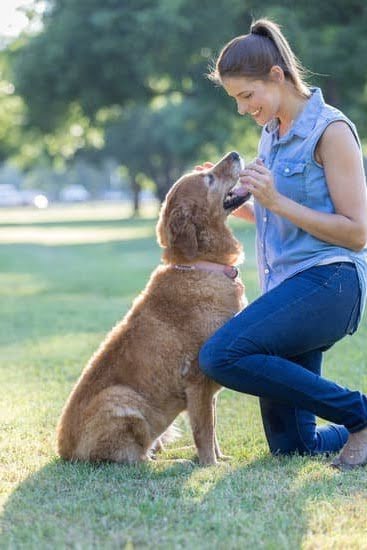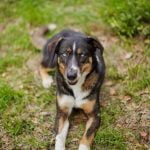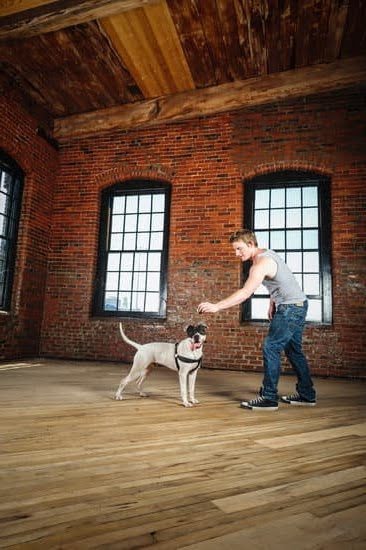Introduction
Training a dog to look at you is essential in order to establish a trusting and strong bond that will last for life. Making eye contact with your dog is an excellent way to communicate and express affection, as well as build trust. It also provides you with important cues to quickly convey commands such as sit and stay. Teaching a dog to look at you does not require extensive training or complicated techniques; all it takes is consistency, patience, and reward.
Start by introducing a cue word like “Look” or “Give me eyes”. Stand in front of your pup, hold out a treat near their snout, and say the cue word. As soon as your pup makes eye contact with you, even if it’s only for a split second, praise them enthusiastically and give them the treat while repeating the cue word. If they don’t make eye contact immediately, increase the distance between the two of you until they do look up at you. Over time give your pup more treats when they are able to make eye contact for longer periods of time before rewarding them. This will prove to them that this behavior reaps rewards!
Once your pup has understood what “look” means during sessions when food rewards are given, gradually reduce the number of treats while allowing more opportunities to practice eye contact with distractions around (e.g., other humans/dogs). Eventually pawing from excitement may replace acknowledged glances towards the handler which is encouraged too!
When training always ensure that all distractions present are minimal, especially when first teaching cue words such as “look”. Motivation has proven invaluable in reinforcing desired behavior such as effectively making eye connections with one’s furry companion as treats can be very attractive! Otherwise try using toys or verbal praise instead which will help in guiding your pooch back onto task when needed whilst still being motivating enough for adherence and further positive reinforcement .
Establishing Trust
When teaching your dog to look at you on command, it is essential to first establish trust between the two of you. Building trust begins with an understanding and respect between animals and humans, as well as fostering constructive communication channels. Here are a few tips to do so:
• Show affection and attention – Allowing your dog to feel included, valued and loved will help create a bond. Even if they don’t necessarily receive food rewards like treats or toys during action repetition training, their enthusiasm increases when they are feeling appreciated by their owner.
• Consistency – Keeping consistent in actions and reactions can help your pet understand expectations more clearly. Dog’s respond best when tasks stay the same rather than varying for different needs or moods. Additionally, utilizing positive reinforcement over punishment helps motivate your dog to reach goals faster than if held back with reprimands.
• Establishing boundaries – Clearly showing rules of expectations from both parties avoids confusion and allows a healthy relationship to flourish. Respectively teaching your pet how far they should be, what is off limits without being harmful allows dogs to understand room for independence while still feeling secure under guidance.
• Give plenty of praise – Acknowledging good behavior supports development of obedience that looks at you on command eventually becomes second nature. No matter how many times a task must be repeated for mastering to occur give verbal affirmation when it is successful in order for the progress made throughout sessions not go unnoticed restoring motivation after mistakes are made long the way.
Create Eye Contact with Treats
When training a dog to look at you and make eye contact, one of the best tools to use is treats. As long as it’s something your pup loves, it will be an excellent way to entice them to focus and maintain eye contact. Examples of treats that can be used when teaching a dog to look at you include small pieces of hot dog, cheese, or other healthy treats. If you don’t want to give your pup treats all the time, toys and interactive activities such as hide-and-seek are also effective ways to train your pup to make eye contact with you. Additionally, using verbal commands such as “look” or “watch me” can further encourage eye contact and help reinforce the connection between your pup and yourself. Once they consistently make eye contact, making sure they are properly rewarded with either a treat or praise can further boost their interest in looking at you.
The Hand Signal
1. Start in a quiet environment with not too much distraction. Get your dog’s attention with a treat or toy and hold it up at eye level – this should capture their gaze.
2. Hold your hand up to the side of your face and give the verbal cue „look“ or „watch“, whichever you prefer. Make sure that the verbal cue is said clearly, as this will be what your dog associates with the action.
3. If your dog does not look towards you after saying the verbal cue, reward him for looking in the direction of your hand anyway (but don’t repeat the verbal cue.)
4. Once you get eye contact when giving the verbal cue, give rewards for his behavior by either providing treats from the treat bag or playing a quick game such as tug-of-war with a toy. This can help give positive reinforcement and encourage better reactions to future uses of the hand signal.
5. Repeat Steps 1–4 several times, rewarding each successful reaction to your signal till your pet becomes familiarized with it and looks towards you when given.
6. Once comfortable giving signals repeatedly to establish eye contact, start moving around while doing this to generalize his understanding of hand signals outside of just a stationary position so he’ll look toward you regardless of where he is located in comparison to yourself during training sessions.
Rewards and Consistency
Rewards are an important part of training your dog to look at you. Positive reinforcement will make sure that your pup learns to associate the desired behavior with something good; this helps reinforce their actions and encourages them to do it again in the future. To use rewards, give your dog treats or toys whenever they look at you. Try giving verbal praise or petting them as well, though a primary reward should be something tangible that they can hold on to — like food or a toy.
It is also important for success in training any kind of behavior to be consistent. For example, when teaching your dog to look at you try rewarding them every time you call their name, so that they begin associating your voice with getting a treat. As the training progresses, lower the frequency of treats until only rewarding occasionaly – but still often enough that they remember what they’re supposed to do and that it is worthwhile. Rewards should also be varied – praise one day, food treats another , and toys another — so that your pup doesn’t get bored of always receiving the same reward all the time!
The No Command
Training a dog to look at you when you want them to requires an understanding of boundaries and patterns of behavior. One way to ensure your pet understands the boundary between acceptable and not-acceptable eye contact is by assigning it a verbal command. For example, ‘eye’ or ‘watch me’ when you want your pup to make direct contact with you. If he doesn’t follow commands, use a light tap on the nose or cluck your tongue. Never physically hit or harm your pet; these methods will only reaffirm any fears or distrust they may have and make it more difficult to achieve the desired result in the future.
In addition, it’s also important to set parameters for when eye contact should not be made. Keep in mind that dogs get easily distracted, so if there are distractions around, like people walking by or other animals close by, it can break their focus on following your commands. When this occurs and your pup does not look back at you, be sure not to reprimand them because they just got distracted, but instead train him again in those moments so he can learn self-control and maintain his attention on you even during high distraction states.
Properly Timed Praise
Training your dog to look at you begins with providing it with proper guidance and positive reinforcement. The key is to pay attention to when you are praising your pup, as this will help the animal better understand which behaviors are valuable and welcome. To ensure that your boat knows when it is being praised for looking in your direction, make sure that you are reacting swiftly. Immediately after the pup looks at you, offer verbal praise such as “yes” or “good!” Pair that positive feedback with treats or other rewards in order to ‘cement’ the behavior into their routine. It is also important to show enthusiasm during your training sessions; if you yourself seem excited about teaching them how to look at you, they are more likely to continue doing what they have been encouraged after. Additionally, be sure not to overdo your praise and treats so that they don’t start expecting goodies every time they glance at you. With a few training sessions and lots of cheer leading, the pup should begin following the command naturally.
Don’t Force the Issue
It is important to remember that when it comes to training a dog to look at you, you should never force the issue. Working with a dog too intensely or for too long can cause the animal frustration, exhaustion, or even aggression. If your attempt to train your pup does not yield the desired result – a glance in your direction – do not push it and instead take a break from training.
On the other hand, if you are seeing results and making good progress, it can be beneficial to put in a little more effort in order to solidify learning and strengthen behavior. With that being said, there should still be an element of mindfulness and consideration when pushing further. Make sure that the atmosphere of the training session remains positive and rewarding. If the atmosphere remains upbeat while continuing to practice, it will help reinforce positive behavior in your pup so they can learn better and faster with each passing out session.
Conclusion
After following the steps listed above, you can now train your dog to look at you in a positive and familiar way. It may take some time for them to learn this response, but it is achievable if you commit to repetition and reinforcement. Once your dog has mastered looking at you on cue, you can move on to more complex commands such as sitting or staying. This kind of advanced training can be both rewarding and beneficial for deepening your bond with your pet. Additionally, there are plenty of other resources online that provide tips, advice, and exercises for further training – so take advantage of these! With patience and practice, soon enough, you’ll have a furry friend who can obey almost any kind of command.

Welcome to the blog! I am a professional dog trainer and have been working with dogs for many years. In this blog, I will be discussing various topics related to dog training, including tips, tricks, and advice. I hope you find this information helpful and informative. Thanks for reading!





